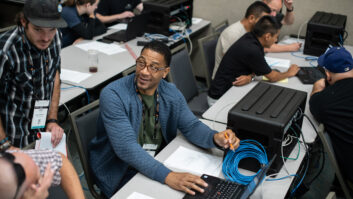Hopefully AVAD hasn’t started a trend by skipping the exhibit hall at this fall’s CEDIA EXPO. I’d like to think that the annual gathering, set for September 7-10 in Indianapolis, is still worth the freight costs, hotel bills, and staff airfares to the rest of the industry.
After learning through the grapevine that the national distributor had decided not to exhibit at EXPO in September, I set up a call with AVAD president and general manager Jim Annes to find out more about the decision. Although Annes told me that AVAD still recognizes “the value that CEDIA brings to the industry through education programs and helping people get together to be more effective,” the distributor, he said, rather spend the “several hundred thousand dollars” in exhibit costs on other dealer support programs instead.

Jim Annes, president and general manager, AVAD
“It’s really not driven by cost or that we don’t have the money,” Annes explained. “We looked at how many customers we could better enable with that amount of money via that show or via putting other programs in place to reach a larger audience and better enable them for success with some very pointed and focused programs. For us, it’s really about the deployment of that investment, going to different vehicles that we think have a broader reach. And we still do our road shows at Vend-o-Palooza.”
On the heels of the InfoComm trade show in Orlando, it is clear that not all shows are equal in the eyes of Annes and parent company Ingram Micro. The company issued a press release during that show stating that it had “teamed with” technology manufacturers BroadSign, Doublesight, NEC, Peerless, PopStar, and Sharp, as well as IT solution provider Sherlock Systems to “demonstrate three distinct, hospitality-focused audio visual and digital signage solutions live.”
In that release, Kevin Prewett, Ingram Micro U.S.’s vice president of vendor management was quoted as saying, “InfoComm is a great event to demonstrate the breadth and depth of our hospitality solutions and really showcase all that Ingram Micro, AVAD, and our business partners bring to the table when it comes to custom electronics and digital signage.”
So, if the market is strong, it’s clearly worth the investment. If it’s not, then the money is better spent elsewhere. That’s not to say that AVAD will skip CEDIA EXPO entirely. Annes and his senior management staff still plan to attend the show to meet with vendor partners and rub shoulders with the integrators, their vendor partners will likely have strong exhibits on the floor. “We want to help work with our partners to drive new technologies and new solutions into the market,” Annes said. “That doesn’t change. It’s just a different conduit or channel to doing that.”
When I asked Annes to cite specific examples of where AVAD was redeploying its resources, he said that a lot of new programs were already underway, including an expansion of its system design team service to include a technical support group to assist on IP-centric networking projects and for integrators making the move from analog to digital solutions.
“We’ve got to be there to help [integrators] enter those solutions by investing in technical support capabilities as well driving some new programs to address as the housing market that has hit its lowest level in new starts since 1967. We have to help our customers get into new markets, not just alert them to the opportunity but to help drive them to them.”
Specifically, Annes said, AVAD hopes to assist integrators in reaching potential customers in a strong rental market and on retrofit projects. So, he said, integrators are going to see several new capabilities offered on how to identify the opportunities as well as address them with the right mix of products and services.
During our call Annes made a convincing case for the great potential in the U.S. rental market, for residential integrators. He cited growth in rentals versus the stagnate new housing starts statistics, pointing out that rental prices continue to increase as consumers build up cash reserves.
“So salaries have gone up, the job market has somewhat stabilized and is improving, and you have a large group of potential customers—both residential and commercial—who have income and want to improve their experience in their home or place of business,” Annes explained. “They just aren’t buying new spaces or building new buildings.”
So AVAD has begun working with its dealers to identify the rental price tipping point for people that have a large amount of disposable income. During a recent Irvine, CA road-show class, Annes said, he shared demographic data that showed more than 150 homes within 11 miles that had rents over $5,500 a month. Because that meant someone was spending $70,000 a year on rent, they most likely would want to enhance and improve their living environment in some way.
Next, Annes pointed to the personal savings rate in the U.S., noting that it was below zero during the housing boom, then went all the way up to 7.5 during Q4 of last year. “Now it’s come back down to a little over five percent, which signals that consumers aren’t saving as much, and are freeing up income to spend on consumer goods,” he stated.
Sounds plausible enough. The hard part is locating specific potential customers within the broader data numbers. Annes suggests contacting relocation agencies that are tasked with finding rental properties for executives on the move. “These executivs often have bonuses, for example, to spend on anything from a refrigerator to a flat-panel television to a distributed audio system,” Annes noted. “Building relationships with those relocation companies as well as moving companies and real estate agents who specialize in the rental market, is the key. People, I think, still don’t understand the huge market out there that real estate agents play in the rental piece, actually brokering rentals, especially in the high end.”
Another route, Annes noted, is driving attachment and expansion opportunities within rentals. “So once you are able to put in a custom system, so to speak, in the rental property, it is only limited because you can’t cut holes in the ceiling or walls. How do you keep in touch with those consumers when they’re ready to move?” he asked.
Annes instructs integrators that delve into the rental market to get in the “moving business” as well, by tagging equipment (for a fee, of course) and helping move the components to the client’s next home, to be re-installed and maybe even expanded.
“So you may have put in a receiver that was only working on one zone on your client’s 1,600-square-foot condo, but they move into their new home and since you had a dual-zone or multi-zone receiver, you can expand that to distributed audio throughout the home,” Annes said. “That’s kind of just the tip of the iceberg out there, but it’s a big market in our estimation that hasn’t really been addressed.”
So despite the disconcerting news about AVAD at EXPO, at least the distributor is thinking outside the box by offering concrete examples to dealers looking to improve their fate during challenging times. I give them a lot of credit for that.






